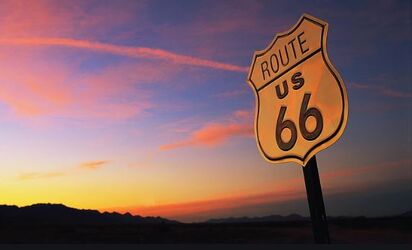|

U.S. Route 66 (also known as Highway 66, the Will Rogers Memorial Highway, the Mother Road, the Main Street of America, or simply Route 66) is one of the original highways on the US Highway System, stretching from Chicago to Los Angeles. As the age of the automobile arose, Route 66 gained an iconic place in American culture and folklore. It was considered a major component of the iconic tradition of the great American roadtrip, where Americans would travel cross-country to see the sights and experience the open road.

On Doomsday, its two endpoints at LA and Chicago were burned by nuclear fire during the bombings of those cities. Vast stretches of the route in between, however, became a major conduit for the migration of refugees throughout the United States.
As of 2020, car traffic only exists in very small amounts, as most ordinary people travel by horse, wagon, steam engine train, or bicycle. Nevertheless, Route 66 persists as a major thoroughfare, and gained a great deal of post-Doomsday history and folklore in the process.
Pre-Doomsday[]
Doomsday[]
On Doomsday, the Route 66 corridor suffered from Soviet nuclear strikes at virtually all the major cities along its length:
- Chicago, IL
- Springfield, IL,
- St. Louis, MO
- Tulsa, OK
- Oklahoma City, OK
- Santa Fe, NM
- Albuquerque, NM
- Flagstaff, AZ
- San Bernardino, CA
- Los Angeles, CA

An artist's imaginary impression of the aftermath of the nuclear strikes in the Los Angeles area.
As a result of these strikes, Route 66 was left segmented, and the areas closest the major cities were rendered unsafe.
In the areas in between these strikes, there were vast stretches of road with motorists who now would have to find refuge in the surrounding countryside.
"The Refugee Road": Route 66 in the aftermath of Doomsday[]

A photo said to have been taken a few days after Doomsday, showing refugees wandering along one of the more battered sections of Route 66.
In the weeks after Doomsday, many older cars (i.e. those without many electronic components) had been able to survive the EMPs released by the atomic detonations and kept going. However, the collapse of trade networks meant that fuel supplies started to dwindle, and many people found themselves forced to abandon their cars and move on foot. Throughout this ordeal, Route 66 served as a major thoroughfare for refugees moving up and down the continental US.

Photos taken of groups of nomadic penitents along Route 66, who believed that the world had been punished for the sins of the 20th century such as the World Wars, and wandered across the landscape fasting, singing hymns, praying, and seeking forgiveness.
In the months after Doomsday, Route 66, along with many other major US highway routes, became the pilgrimage trails of bands of religious penitents who believed that Doomsday had been divine punishment for the sins of the 20th century. These nomadic groups of penitents, much like the flagellants that roamed the roads of Europe during the Black Death of the 1300s, wandered the roads devoting themselves to fasting and prayer for forgiveness. Some groups did, in fact, imitate the flagellants of the Middle Ages, by whipping themselves along the way as a form of atonement for their sins.
Route 66 in the early 21st century[]
In modern times, the surviving segments of Route 66 have once again become important trade routes between the surviving settlements along the way.
As in the years immediately after Doomsday, it has continued to be an important site for religious pilgrimages. Some groups of pilgrims have continued the post-Doomsday tradition of fasting and sometimes even whipping themselves to seek forgiveness for the sins of the pre-Doomsday world. However, these penitents have become much less representative of the pilgrims in recent years.
The vast majority of religious pilgrims along Route 66 in the early 21st century tend to follow more mainline expressions of devotion, such as singing hymns, holding prayer services for the fallen, and setting up memorials along the roadway for those who died in the nearest targeted area of the Mother Road.
